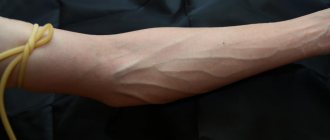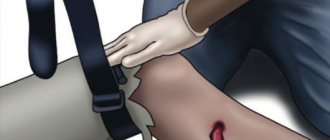The eyeball is a very vulnerable organ, and any excessive impact on it can result in vision problems. It happens that a person may find red spots of various sizes in his eye, which are hemorrhages. They occur when the blood vessels of the eyes are damaged and represent the release of blood beyond the vascular wall. This does not look entirely aesthetically pleasing, but it rarely causes any physical discomfort to the patient. So why do blood vessels burst in the eyes and how dangerous is this condition?
Causes of broken capillaries in the eyes
Below we will present and consider in detail the most common causes of ruptured capillaries in the eyes.
Arterial hypertension
The main reason why blood vessels burst is high blood pressure. Most often this occurs in those who have hypertension complicated by a hypertensive crisis. The brain, liver, heart and eyes are most affected by this disease.
What is a hypertensive crisis? It is a sudden increase in blood pressure to extremely high numbers, determined for each individual. That is, for some it can begin already at a pressure of 140/90 millimeters of mercury, while for others only at 200/100 millimeters of mercury. In this case, the vessels located inside the eyeball lose their elasticity and rupture, as they cannot cope with the increased blood flow.
Great physical activity
If you engage in active physical labor for a long time, there is a high probability of vascular rupture. During heavy lifting or active sports, blood pressure rises, which, as in the case of hypertension, causes capillaries to burst.
Eyeball injuries
The reason for the appearance of burst vessels may be a bruise or blow to the eyeball. Hemorrhage is also common in cases of clinical intervention, such as lens replacement surgery.
Diabetes
This disease is characterized not only by a deficiency of insulin in the blood and an increase in glucose, but also by damage to capillary vessels. This can be explained by the fact that an excess of glucose has a negative effect on the walls of blood vessels, as a result of which they become thinner in some areas and thicken in other areas. This process leads to a decrease in the elasticity of blood vessels, which also affects their strength.
Eye fatigue
Eye fatigue has become a common disease for every office worker. Increased pressure on the eyes is observed in those who spend a lot of time at the computer or reading, especially texts in small print. Also, poor lighting and long hours of work without rest breaks can lead to rupture of capillaries (important for students during the exam session), since the eyes are constantly under tension, there is a constant flow of blood to the eyeballs, which leads to rupture of the capillaries.
Sudden change in weather conditions
Those people who can be classified as weather-dependent often suffer from ruptured capillaries in the eyes. This is due to a sharp increase or decrease in blood pressure.
Inflammation of the cornea
Inflammatory processes in the eyes often lead to redness. Inflammation can be triggered by mechanical trauma to the retina, allergies, mechanical or thermal burns, or foreign bodies entering the eye. Also, the cause of inflammation of the cornea can be a disregard for eye hygiene. Symptoms of this disease, in addition to rupture of capillaries, are lacrimation and intolerance to bright light.
Read: Hemorrhage under the conjunctiva is called subconjunctival hemorrhage.
Conjunctivitis
The reasons for the appearance of this disease are the same as for inflammatory processes in the cornea. Often they occur simultaneously. Symptoms include itching, burning, discharge from the palpebral fissure, and rupture of blood vessels.
Neoplasms of the eyeball
The appearance of a tumor on the eyeball will invariably lead to deformation of the blood vessels of the eye, making them susceptible to rupture.
Lack of vitamins in the diet
If you do not consume enough vitamins C and P, this can cause the vascular wall to thin, so that it becomes easily vulnerable and bursts.
Fragility of vascular walls
The condition of blood vessels is affected by medications and eye diseases, which can cause increased fragility of blood vessels.
Head injuries
In the case of traumatic brain injuries, there is often a disruption in the blood circulation in the brain and the outflow of cerebrospinal fluid, which can cause an increase in blood pressure in the vessels of the eyes.
Overheat
If you like to visit a bathhouse or sauna, then burst capillaries may be a sign that you have stayed there too long. If this happens rarely, you have nothing to worry about. However, if you experience regular symptoms, you need to stop going to these places and immediately consult a doctor.
Also, rupture of the vessel can be caused by sunstroke or being in a room with too high a temperature.
Improper wearing of contact lenses
Many of those who use contact lenses neglect their care. To prevent eye bleeding, change your lenses regularly, remove them at night, and do not leave them on if you feel discomfort. Rubbing the eyeball not only contributes to the appearance of burst blood vessels, but also the development of a number of eye diseases.
Alcohol and drugs
Excessive alcohol and drug use leads to a sharp increase in blood pressure, which causes burst capillaries.
Poor quality mascara or eye shadow
Bad cosmetics can cause hemorrhage. Always check the expiration dates of cosmetic products, and also, if you have sensitive eyes, buy only those mascara and shadows that have been approved by ophthalmologists.
Tears
While sobbing, a person involuntarily begins to rub his eyes, which leads to damage to the capillaries. Tears, which contain salt, irritate the damaged areas even more, so a person instantly becomes inflamed.
Symptoms
This pathology has one pronounced sign - a reddened eye with a bloody spot on it. It can be very small and barely noticeable if only one capillary has burst, or it can cover the entire front part of the eyeball if there are several vessels that have burst. It is worth noting that redness can only be observed if the torn vessel is located on the front visible part of the eye, but it can also be located behind. In this case, you will feel a slight heaviness in your eyes.
What are the types of hemorrhages in the eye?
Experts divide hemorrhages in the eyes into several categories, depending on their location. Next we will look at each type in detail.
Retinal capillary rupture
This type of hemorrhage can lead to complete loss of vision. The retina, which is part of the eyeball, contains receptors through which visual perception occurs. That is why a burst capillary disables some important receptors. Patients who experience this type of hemorrhage may complain of the appearance of floaters and blind spots, as well as sharply decreased clarity of vision.
Rupture of orbital vessels
With this type of hemorrhage, blood cells penetrate into the fat cell, which is located behind the eyeball. Symptoms of this pathology include swelling, bruising under the eye, protrusion of the eyeball from the socket, pain during movement of the eyeball.
Rupture of blood vessels in the vitreous body
Thanks to the vitreous body, light rays pass through and hit the retina. In case of hemorrhage, the transparency (transparency) of the vitreous body is impaired, which manifests itself in the form of a sharp drop in the quality of vision.
Rupture of blood vessels in the anterior chamber
The most common causes of this type of hemorrhage are trauma and glaucoma. A characteristic feature is a hematoma located in the lower part of the eyeball.
Rupture of a vessel into the sclera or conjunctiva
This type of hemorrhage in the eye is the most common. It leads to redness of the whites of the eyes, as well as hyperemia of the conjunctival membrane on the upper and lower eyelids. The consequences of this disease can include photophobia, the feeling that there is something foreign in your eye, watery eyes, dry eyeballs, and blurred vision.
Our services in ophthalmology
The administration of CELT JSC regularly updates the price list posted on the clinic’s website. However, in order to avoid possible misunderstandings, we ask you to clarify the cost of services by phone: +7
| Service name | Price in rubles |
| Appointment with an ophthalmologist (primary) | 3 900 |
| Comprehensive OCT examination of the retina (one eye) | 3 500 |
| Ultrasound scanning of the anterior segment of the eye | 1 000 |
| Revision of the vitreous cavity | 44 000 — 70 000 |
All services
Make an appointment through the application or by calling +7 +7 We work every day:
- Monday—Friday: 8.00—20.00
- Saturday: 8.00–18.00
- Sunday is a day off
The nearest metro and MCC stations to the clinic:
- Highway of Enthusiasts or Perovo
- Partisan
- Enthusiast Highway
Driving directions
What to do if a vessel in the eye bursts?
If you notice that a vessel in your eye has burst, you should consult a doctor. Only a professional ophthalmologist will be able to give you an accurate diagnosis and prescribe treatment that will help you completely cope with the problem.
In case of injury to the eyeball, you should consult a doctor immediately!
Prescribing treatment is not a mandatory procedure, since in some cases (overload, sports activity, overheating) the redness will go away on its own within a couple of days.
Less dangerous conditions
Capillaries can be destroyed due to completely different factors, no less serious:
- high temperature due to colds, infectious and viral diseases;
- allergic reaction to dust, pollen, pet hair;
- alcohol abuse;
- increased weather sensitivity.
[media=https://www.youtube.com/watch?v=veIeVXPZOH8]
In any case, any hematomas in the left or right eye, even in less dangerous conditions, should be taken seriously and monitored. If the bruise does not go away for a long time and the eye hurts, then you need to visit an ophthalmologist.
Common causes of the problem
The first thing that interests those who have a burst vessel in the eye is the causes of the phenomenon. The phenomenon can be triggered by many factors, such as:
- Vessels are too fragile.
- Blood pressure surges.
- Diseases that affect blood vessels, their elasticity and strength. Such diseases include diabetes mellitus and other endocrine pathologies, as well as hypertension.
- High strain on the eyes. For example, this happens when working at a computer for a long time.
- Alcohol abuse or visiting the sauna. This does not mean that you cannot go to the sauna at all. It’s just that sometimes it can contribute to the rupture of a blood vessel in the eye.
- Sudden changes in atmospheric pressure. The impact of such changes is possible only when a person is too sensitive to weather changes and these changes negatively affect his well-being.
If the reasons why blood vessels in the eyes burst are eye strain, a sauna, alcohol or a change in weather, then you should not worry too much about the consequences of the phenomenon. It will go away on its own over time and may not appear again at all. Or it will appear, but again for some frivolous reason and in the distant future.
Treatment
Only an ophthalmologist can prescribe treatment. Regular eye drops for several days are usually sufficient to relieve inflammation. For conjunctivitis, it is necessary to use drops that contain an antibiotic. In other cases, using only moisturizers may be sufficient.
Remember that burst capillaries can be a harbinger of other, much more serious diseases.
After a detailed examination and diagnosis of the disease, the doctor should prescribe you a course of therapy, which will be aimed at eliminating the causes of redness of the eyes.
Prevention
The appearance of burst blood vessels can be prevented by following a number of recommendations. How can you prevent the occurrence of broken capillaries?
- First of all, take a closer look at your diet. Add more foods containing ascorbic acid and rutin to it. They are found in many vegetables and fruits, for example, oranges, tangerines, spinach, lettuce, and bell peppers.
- Reduce the amount of physical activity, do not carry heavy objects, and do not be excessively zealous in sports activities.
- If you work a lot with the computer and documents (especially with small print), then give your eyes a break every couple of minutes, and also do a special warm-up.
As a warm-up, you can use the following exercise: look into the distance, and then look at the tip of your nose. Repeat this at least fifteen times.
Adviсe
- Do not go to the bathhouse or sauna too often, as heat and high humidity can cause hemorrhage. By the way, you need to be especially careful in public baths so as not to catch infections there.
- Do not delay treatment of colds. At the first signs of illness, start taking antiviral medications, and also take vitamin C in large quantities, which will help protect blood vessels from destruction.
Vitamin C strengthens the walls of blood vessels, making them more elastic. He is also an active participant in hematopoiesis.
- Protect your eyes with goggles during windy weather and wash them immediately when you return home.
- If you have diseases of the endocrine system, as well as hypertension, then take all medications prescribed to you in a timely manner. In this case, symptoms, including bleeding in the eyes, will not have a chance to develop.
- Try to get a good night's sleep, this will not only give you strength, but also eliminate the appearance of bloody spots on your eyes.
- If you have air conditioning in your home, install humidifiers to prevent your eyes from drying out.
- If you receive a mechanical injury, immediately consult a doctor for advice. Some injuries require prompt medical professional help. Fulfilling this condition will help preserve your vision.
- Hemorrhage caused by bacterial conjunctivitis requires special treatment with antibacterial and anti-inflammatory drops. This will help prevent red spots from appearing.
Prevention
With frequent episodes of damage to the eye vessels, you need to pay attention to a nutritious diet enriched with vitamins. You should get rid of bad habits: smoking, alcohol and coffee abuse. It is important to maintain the correct rest and wakefulness regime. Sleep should last at least 8–9 hours a day.
If possible, you should minimize the time spent in front of the TV or computer. When working with these devices, you need to use protective glasses and periodically do exercises from a complex of gymnastics for vision. Be sure to give your body regular moderate physical activity.
Thus, in most cases, a burst eye vessel does not pose any danger to humans, and the situation resolves within a few days or 1–2 weeks. But if these cases often recur, you should definitely undergo an examination by an ophthalmologist and related specialists.
Popular eye drops
Manufacturers offer a huge number of eye drops designed to relieve redness if a vessel in the eye has burst. Below we will look at the most popular of them.
- Visine. Used to relieve redness from the eyes. The mechanism of its action is as follows. Due to the components in its composition, similar in chemical composition to natural human tears, it makes the removal of eye hyperemia faster and also promotes the resorption of hemorrhage. It has a moisturizing effect, which is especially important for people who constantly wear lenses. The product should be instilled into the outer corner of the eye several times a day.
- Emoxipin. These drops were developed specifically to combat the consequences of burst blood vessels in the eye. A clear or slightly yellowish solution should be instilled three times a day until the redness completely leaves you.
- Hyphenation. These drops are necessary to prevent dry eye syndrome, which can cause broken capillaries. Its action is similar to Visine.
- Taufon. This drug is usually recommended for patients with glaucoma. Its goal is to quickly resolve hemorrhages in the eyes. Thanks to its properties, it quickly relieves redness. It should be used every twelve hours, two drops in each eye.
Internal factors
Internal factors include those that depend on the state of human health. Thus, they notify a person about internal problems.
Internal factors are mainly serious diseases that continue to develop and progress.
Causes of weak internal vascular walls:
| Cause | Description |
| Arterial or intracranial hypertension | A hypertensive crisis is characterized by a sharp jump in pressure and the capillaries of the eye cannot withstand the tension. Bursted blood vessels in a hypertensive patient signal a serious problem that needs to be solved in a complex manner: treatment and normalization of the diet. Otherwise, next time the blood vessels may burst in the head. |
| Diabetes | The development of the disease quickly leads to pathology of blood vessels. Diabetic retinopathy is one of the most severe complications of diabetes, affecting the vessels of the retina of the eye, which leads to significant deterioration or loss of vision. |
| Ophthalmic diseases | Tumors of any nature, eye diseases: glaucoma, conjunctivitis, blepharitis, keratitis and others. |
| Hematological pathologies | Diseases that are characterized by increased bleeding in all organs, including the optic membrane: hemophilia, lymphoma, leukemia, thrombocytopathy. |
| Avitaminosis | A lack of vitamins A and C will lead to impaired elasticity of the vascular walls. |
If a vessel in the eyeball has burst and you feel pain in the affected area, you should immediately visit a specialist.
Signs of what diseases
If you notice that you often have bloody spots on your eyes, then this is a serious reason to consult a doctor and conduct examinations for possible diseases.
Keratitis
Keratitis manifests itself in the form of redness of the eyes, increased tearing, and clouding of the cornea. The causes of this disease are allergies, thermal burns, foreign bodies, viruses or fungi. Rupture of capillaries indicates that your body is affected by this disease. To treat it, you need to start taking antiviral and antifungal drugs. As soon as you notice the first symptoms, consult a doctor immediately to avoid consequences in the form of damage to the cornea of the eye.
Conjunctivitis
Conjunctivitis affects the thin transparent film of the eye, thereby causing eye irritation and bursting of capillaries. The causes of its occurrence may be vitamin deficiency, various infections, or the consequences of an allergic reaction. There is a burning sensation in the eyes, but the most characteristic sign is bloody spots on the eyes. The disease can have several forms, including allergic, viral and bacterial. You can become infected with conjunctivitis through airborne droplets. Treatment occurs with medications.
Avitaminosis
Vitamin deficiency, if not eliminated in time, can develop into a serious illness. One of the signs that gives it away is burst capillaries. First of all, for treatment you need to go to a clinic, and also change your diet to saturate it with the necessary vitamins and minerals.
Injuries
Some head injuries go virtually unnoticed, such as minor concussions from a fall from a bicycle, skate or skateboard. However, they have a strong negative impact on human health. Broken capillaries may indicate the presence of internal trauma. If constant fatigue, insomnia and nausea are added to this, you should immediately consult a doctor.
Hypertensive crisis
The appearance of a hypertensive crisis is always unexpected, but broken capillaries in the eyes can indicate it. It is accompanied by a sharp increase in blood pressure, which is very dangerous for humans. There may be a risk of a number of complications. These include stroke, myocardial infarction, and aortic dissection.
Glaucoma
Glaucoma is a disease caused by constant increased pressure inside the eyeball. Therefore, it is not surprising that its characteristic feature is constant redness of the eyes due to burst capillaries. It can lead to complete loss of vision. The disease belongs to the category of long-term with periodic outbreaks of exacerbations. The consequences of crises should be stopped within two to three hours, otherwise this may cause the death of the optic nerve.
Coagulopathy
Another disease that may indicate constant redness of the eyes is coagulopathy. It occurs as a result of an overdose of drugs whose purpose is to thin the blood. They are mainly taken by people with heart disease and arrhythmia, as well as those who must take these medications as a preventive measure for thrombosis.
Broken blood vessels in the eye in children
It is normal for newborns to have broken capillaries immediately after birth. According to statistics, this happens approximately once in five cases of natural childbirth. And if additional stimulation is used during labor, then hemorrhage in the eyes can occur in almost fifty percent of cases.
Treatment of blood vessels in the eyes with special methods at this age does not require special methods. They disappear on their own within two to three weeks.
In teenagers and schoolchildren, the causes of blood spots on the eyes are similar to the symptoms of adults. If you notice that your child is bleeding in the eyes on a regular basis, then this is a reason to immediately consult a doctor. This symptom may be a sign of the presence of diseases associated with brain activity. It can also signal serious overwork and high stress levels. You should monitor how much time your child spends on computers and under what conditions he does his homework.
External factors: negative impact on the eyes
When a blood vessel ruptures in the eye, you should not immediately panic. Perhaps this is simple overwork, which occurs quite often. In this case, no special treatment is required, but you just need to give your eyes a rest.
This problem is especially relevant among office workers and those who read a lot and spend time at the computer.
Other factors can also influence the condition of the capillary network:
- strong wind;
- sunny weather;
- high atmospheric pressure;
- low air humidity;
- unventilated room;
- long stay in a bathhouse or sauna;
- great physical activity;
- injury or damage to the eyes.
Problems with the blood vessels of the eyes can occur due to disrupted sleep and rest patterns. These factors several times increase the risk of vascular dysfunction of the eyes and bruises.









